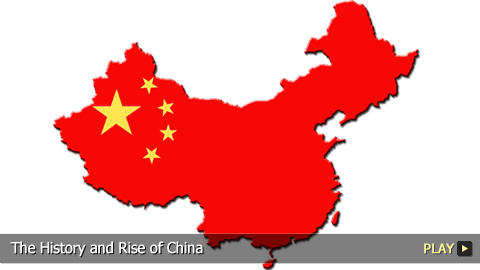The History and Rise of China

advertisement
VOICE OVER: Rebecca Brayton
After the Qing dynasty was overthrown in 1912, the country was faced with finding new leadership. Finally, on October 1st, 1949 – after years of fighting – Mao Zedong declared the People's Republic of China. His communist regime sought to stamp out traditions and cultural symbols of the times that came before, and most importantly wanted to unite the country under a communism. Successes and failures followed, but ultimately China became the world's fastest-growing economy and an important power on the world stage. This was seen by some as a threat to the West, and the United States in particular. In this video, http://www.WatchMojo.com traces the history and rise of China.
The Rise of China
This is the oldest continuous civilization in the world. Welcome to WatchMojo.com, and today we’ll be taking a look at the rise of China.
The End of Imperial Rule
Centuries of Imperial rule ended when the Qing dynasty was overthrown in a series of uprisings that began on October 10th, 1911. On February 12th the next year, the Republic of China officially replaced the dynasty, but this was not the end of the country’s inner struggles.
The Warlord Era
After a second failed revolution in 1913, an attempt was made to declare a new Empire of China. This also proved unsuccessful, and in 1916 the Warlord era began. Until 1928, a series of warlords battled to rule the Beijing government.
Chinese Civil War and Mao Zedong
This overlapped with the beginning of the Chinese Civil War in 1927. The ruling government was challenged for control by the Communist Party of China. Finally, on October 1st, 1949, the People’s Republic of China was declared by Mao Zedong, and the country was split. Mainland China was controlled by a communist regime, while the Republic of China became known as Taiwan.
The Maoist Regime
The Maoist regime aimed to unify the country, and to ensure its independence. However, Mao’s communist principles were most important. Strict societal limits were set, and this resulted in the destruction of important landmarks due to their connections with the past, as well as the executions of those who disagreed with the regime.
The Great Leap Forward
In 1958, the Maoist government began the Great Leap Forward with the aim of quickly converting the country to a communist society. They attempted communal farming, and the industrialization of rural areas; however, this ultimately led to famines, malnutrition and mass casualties.
The Cultural Revolution
By 1961, the Great Leap was considered a failure, and so Chairman Mao became less powerful. Five years later he initiated a Cultural Revolution to eradicate the remaining traditional, cultural and capitalist characteristics from society. Counter revolutionaries were bullied by the Red Guard, political opponents were eliminated and Mao regained his power.
Struggles
However, beneath him the country struggled both socially and financially. School and public transit systems collapsed, and everyday life in China was rigorously managed. Some saw this as a fresh start for the country, while others maintained the Mao regime damaged Chinese culture and caused millions of unnecessary deaths.
Mao’s Death and New Leadership
It was only after Mao’s death in 1976 that the Cultural Revolution truly ended. A fight for power ensued, and by 1980 Deng Xiaoping claimed the “second generation” of Chinese leadership.
Reforms and the Emergence of a Middle Class
He implemented major governmental and financial reforms, instigated the use of a social market economy, and relaxed restrictions on everyday life in China. The standard of living increased, certain sectors of the economy grew, and a middle class slowly developed. During this period, child poverty also declined radically due to the one child policy of 1979.
The Tiananmen Square Protests
Despite improvements in the 1980s, Deng was not unanimously supported. Opposition peaked in 1989 when weeks of demonstrations followed the death of one of the country’s important liberal leaders. After martial law and military strength were used to end the protests, Deng retired.
Increasing Stability
Jiang Zemin and the “third generation” eventually replaced him in the 1990s. The country’s international reputation and stability improved with the application of more reforms. However, materialism, crime, unemployment and pollution also increased.
China Joins the WTO
In 2001, China joined the World Trade Organization. This was after decades of encouragement towards free trade and outside investments.
Closer Ties Between the U.S. and China
Hu Jintao and the “fourth generation” then came to power after the turn of the millennium, and guided the country through the SARS crisis. Meanwhile, the United States and China grew closer politically due to the War on Terror.
The 2008 Beijing Olympics
China’s augmented visibility on the world stage encouraged both scrutiny and fervent Chinese nationalism. This was highlighted in 2008 when Beijing hosted that year’s Summer Olympics.
Today
Today, China boasts the world’s largest population at 1.3 billion, is strong militarily and has the world’s fastest-growing economy. It is estimated that, within decades, China will overtake the United States to become the most powerful country on the planet.
The Chinese Threat?
In the West, China’s rise is seen by some as a threat, due to its unpredictable politics and opposing belief system. However, there is no doubt that China’s economic climb has been one of the most important events in the 21st century.

